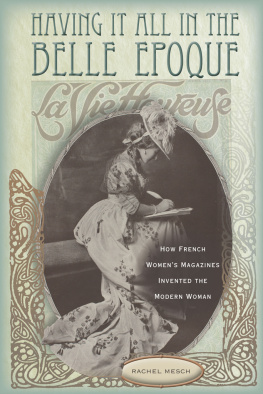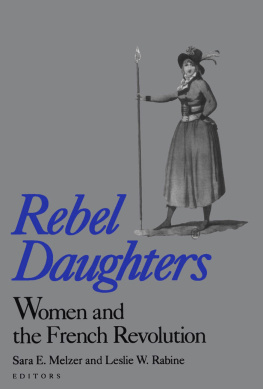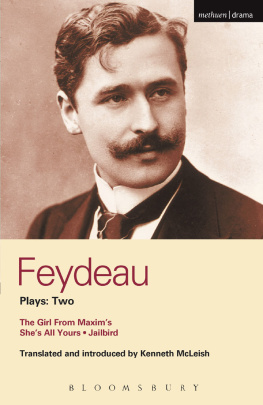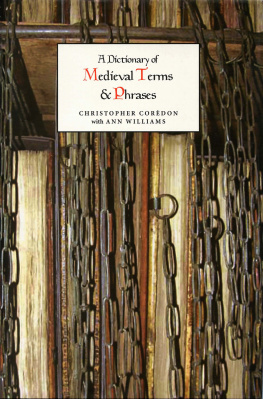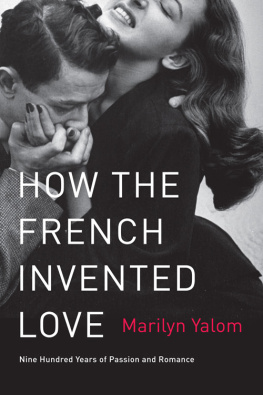HAVING IT ALL IN THE
BELLE EPOQUE
HOW FRENCH WOMENS MAGAZINES INVENTED THE MODERN WOMAN
RACHEL MESCH
STANFORD UNIVERSITY PRESS
STANFORD, CALIFORNIA
Stanford University Press
Stanford, California
2013 by the Board of Trustees of the Leland Stanford Junior University. All rights reserved.
No part of this book may be reproduced or transmitted in any form or by any means, electronic or mechanical, including photocopying and recording, or in any information storage or retrieval system without the prior written permission of Stanford University Press.
Printed in the United States of America on acid-free, archival-quality paper
Library of Congress Cataloging-in-Publication Data
Mesch, Rachel, author.
Having it all in the Belle Epoque : how French womens magazines invented the modern woman / Rachel Mesch.
pages cm
Includes bibliographical references and index.
ISBN 978-0-8047-8424-5 (cloth : alk. paper)
1. Womens periodicals, French--France--History--20th century. 2. French literature--Women authors--History and criticism. 3. Feminist literature--France--History and criticism. 4. Feminism--France--History--20th century. 5. Femininity in literature. 6. Women in literature. 7. Femininity in art. 8. Women in art. I. Title.
PN5184.W6M47 2013
054'.1082--dc23
2013013863
ISBN 978-0-8047-8713-0 (electronic)
Typeset by Bruce Lundquist in 11/15 Bell MT
In memory of my mother,
Caryl Mesch,
and for my daughters,
Abby and Eliza
CONTENTS
ACKNOWLEDGMENTS
It was, in a sense, love at first sight. From the moment I first laid eyes on Femina and La Vie Heureuse, spooling through microfilm in a dark annex at the French national library, I knew that I had to find a way to build a project around them. While researching my first book on French women writers, I had already spent many an hour in these somber research chambers, just above the faint din of the reading rooms where scholars stretched from table to table in what seemed, from my isolated space, like beautiful camaraderie, thumbing through actual books (while, because of the nature of the paper used, nearly everything between 1870 and 1914 could only be accessed through microfilm). If I were going to begin this solitary process again, I should at least have an object of study as gorgeous and tantalizing as these magazines.
As it turned out, there was plenty of paper to be thumbed through, and plenty of camaraderie to be had in what has been not nearly as monastic a venture as the first time around. I have been greatly aided along the way by the collections in the Bibliothque historique de la Ville de Paris, the Bibliothque Marguerite Durand, and the Institut Mmoires de ldition contemporaine, not to mention PriceMinister, TDMpresse, eBay, and the wonderful old magazine shop La Galcante, on the rue de larbre sec in Paris.
I would first like to acknowledge Yeshiva University, which has funded this project through the office of Provost Morton Lowengrub. The book also received two generous grants from the Kenneth Chelst Faculty Book Fund, which supported research in France and publication costs associated with the book. Deans Barry Eichler, Fred Sugarman and Raji Viswanathan have been steadfast supporters and I am grateful for their in Chapter 2). The open doors of Steven Fine, Shalom Holtz, Aaron Koller, David Lavinsky, Ronnie Perelis, Liesl Schwabe, Gillian Steinberg and Ria Van Ryn have in general made the workplace the opposite of lonely. Debra Kaplan fundamentally understands what this book has meant to me, intellectually and personally; at so many times, that shared understanding has made all the difference. Johanna Lane and Silke Aisenbrey, as colleagues, feminist soul sisters and cherished friends, have been integral to this work in ways that I wont even bother to attempt to squeeze into this space.
This project has fundamentally transformed my experience of research, transcending my literary training to force me to think about literary production, communities, feminist history and cultural artifacts in wholly different ways. I am especially grateful to colleagues in disciplines beyond my own who have offered their expertise, as well as those with specialized knowledge that helped inform my analysis. Historian Karen Offen generously read parts of the manuscript and offered her deep knowledge of the multiple feminisms of this time period with detailed, incisive comments. Lenard Berlansteins early generosity and humble support was crucial to moving this project forward. Ruth Iskin has been an incredible resource with her vast knowledge of late nineteenth-century art and consumer culture. Marni Kessler has taught me a great deal through her own work about the analysis of nineteenth-century visual culture; I thank her for reading chapters and responding generously with references and insights.
Closer to my disciplinary home, I am grateful to Margot Irvine, who works on overlapping subject matter, for all of her generous sharing along the way: research discoveries including rare archival finds; deep insights and careful readings of articles and chapters; her own works-in-progress; and tips for charming hotels in Paris. Susan Hiner provided detailed, thoughtful comments that have surely enhanced the quality of this work. Elizabeth Emery, who knows so much about photojournalism, allowed me to read her brilliant chapters in proof form, which instantly became crucial points of reference for my own analysis. She offered careful readings, helpful research tips and cheerful, prompt answers to my multiple follow-up questions. She and Mike Garval, fellow collector/researchers, shared their insights into the perils and pleasures of amassing materials through the Internet. Masha Belenky has been an unwavering source of support since our graduate schools days. Our idyllic shared research trip in the fall of 2010 propelled this project forward through a congenial mix of cafs crmes, croissants and the warm halls of the Bibliothque historique de la Ville de Paris. I am immensely grateful for her friendship as well as for her insightful readings of huge portions of the manuscript.
A book is always the result of many voices and conversations pushing it forward. I am grateful for an early conversation with Lisa Gordis, who picked up on my enthusiasm and urged me to build a new project around the object and questions that were visibly exciting to me. Cathy Nesci has been an enthusiastic supporter and helped arrange an MLA session crucial to the development of this work. Joanna Stalnaker and Vincent Debaene offered invaluable advice and camaraderie as we sought publishers for our works-in-progress. Many pleasurable chats with Andrew Counter, Nigel Harkness, Elisabeth Ladenson, Bettina Lerner, Jann Mattlock, Gerald Prince, Maurie Samuels and Nick White at conferences and cafs around the globe have helped guide me forward.
There have been numerous tasks associated with the production of this book that fall slightly beyond what a PhD in French literature prepares one for. I want to thank my research assistant Daniel Winchester for cataloging hundreds of images of Femina and La Vie Heureuse from my research as well as for coming to my rescue in the preparation of the bibliography. Phone Dumas graciously helped with the herculean task of preparing my images. Katy Adair tracked down materials for me in Paris when I could not get there myself. Clment Oudart generously gave of his own research time to bravely tackle microfilm at the Bibliothque nationale in the eleventh hour. Matthew Udkovich made an emergency trip to La Galcante to retrieve a magazine and always faithfully scoured the bouquinistes for errant Feminas in my absence.
At Stanford University Press, I am lucky to have found an editor with a PhD in French literature herself. I am indebted to Emily-Jane Cohen for her deep understanding of this book and its potential appeal. Emma Harper has been an absolute delight to work with, and I thank Xenia Lisanevich and Mariana Raykov for their copyediting expertise.
Next page
